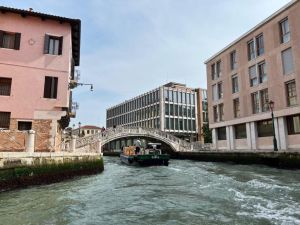Feature, Freight News, Inland waterway, Logistics
Venice Biennale and the fine art of shipping
[ June 11, 2024 // Chris Lewis ]The Venice Biennale is not only the oldest, but arguably the most revered art exhibition in the world. It is also almost certainly the largest with a record 331 artists from over 75 countries invited to participate in 2024, attracting an anticipated 800,000 visitors between April and November.
While all eyes are on the national pavilions, some visitors may pause to consider what it takes to create such a gargantuan global exhibition. Behind the scenes, international specialist logistics teams, many of whom are members of ICEFAT (International Convention of Exhibition and Fine Art Transporters), have been manoeuvring complex requirements for months, working out how to navigate the crumbling city’s waterways to install vast and in some instances delicate works of art.
The architecture of Venice presents complications; it is a pre-requisite for the Biennale that artworks can pass under low bridges and through narrow palazzo doorways or windows, so crates must be constructed with specific margins in mind. This year Atelier 4 shipped the US Pavilion, comprised of works by the interdisciplinary artist Jeffrey Gibson, which varied greatly in size and medium, which required a lot of logistical choreography to get the crates off canal barges and into place.
In the case of the Singapore Pavilion, Helutrans worked closely with Italian agent Apice to oversee the shipment of works by Robert Zhao Renhui. These large-scale multi-media works were first stored in specialist warehousing on the mainland, before being transported across the Venetian Lagoon to the Arsenale. This journey alone had to be meticulously planned to consider the tide and complex waterways that Apice’s boats had to navigate. The experts at Apice oversaw the final stage of many Biennale shipments, each with specific requirements. After receiving works for the Nigeria Pavilion from Atelier 4, for example, Apice designed and constructed a scaffold alongside the exterior of the 16th-century Palazzo Canal, from which the crated works could be winched inside.
ICEFAT facilitates global connections to make these incredibly complex projects much easier to manage. ICEFAT chairperson, Ida Ng, says: “The trust that shippers have for each other, forged from almost half-century of collaboration, means galleries and artists have peace of mind that artworks will reach Venice safely, efficiently and on time.”
From studios worldwide to palazzo doorways in Venice, ICEFAT marries global logistical expertise with local knowledge to schedule, crate, and deliver exhibitions bound for Venetian shores.

Tags: ICEFAT











